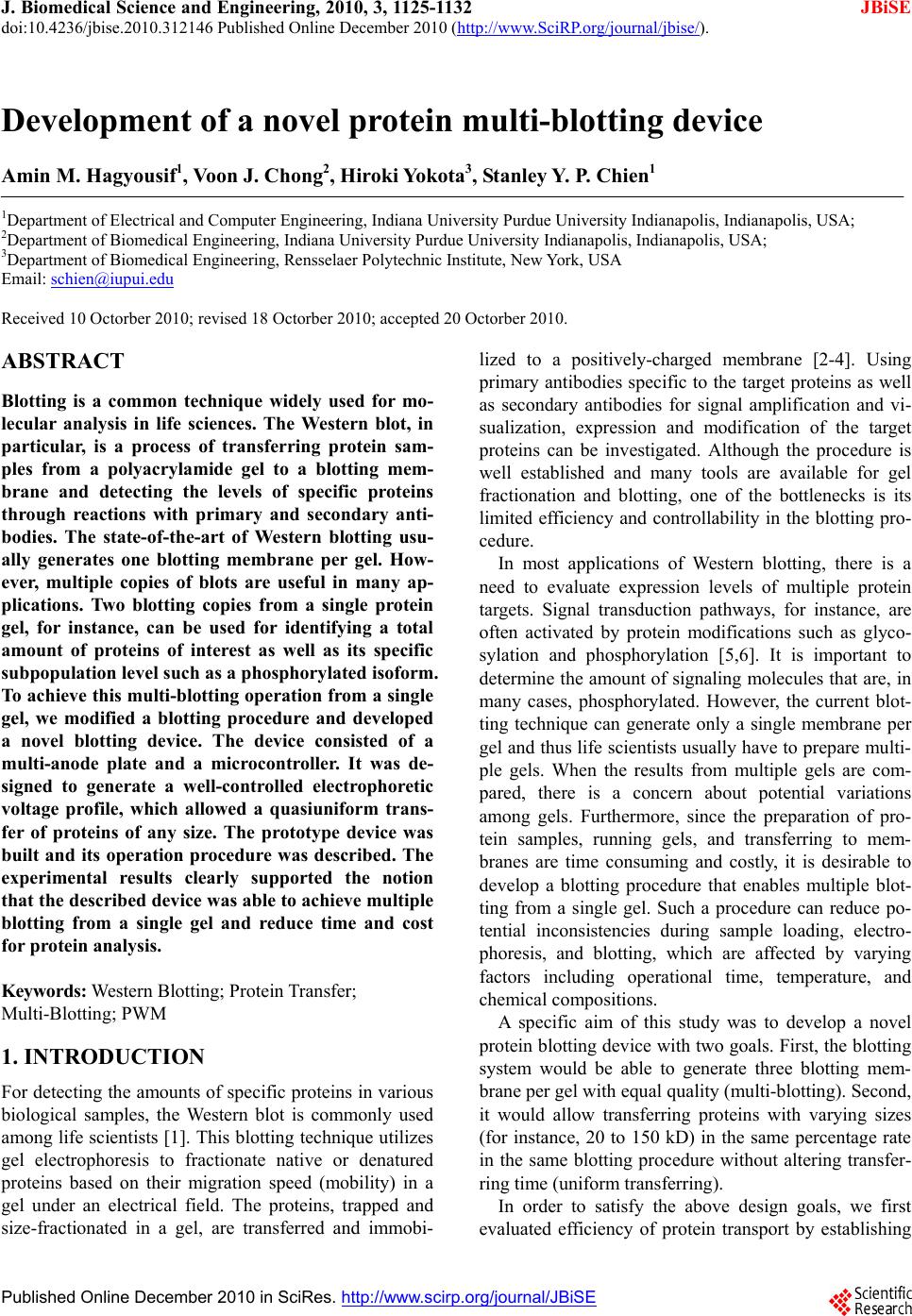
J. Biomedical Science and Engineering, 2010, 3, 1125-1132
doi:10.4236/jbise.2010.312146 Published Online December 2010 (http://www.SciRP.org/journal/jbise/
JBiSE
).
Published Online December 2010 in SciRes. http://www.scirp.org/journal/JBiSE
Development of a novel protein multi-blotting device
Amin M. Hagyousif1, Voon J. Chong2, Hi roki Yokota3, Stanley Y. P. Chien1
1Department of Electrical and Computer Engineering, Indiana University Purdue University Indianapolis, Indianapolis, USA;
2Department of Biomedical Engineering, Indiana University Purdue University Indianapolis, Indianapolis, USA;
3Department of Biomedical Engineering, Rensselaer Polytechnic Institute, New York, USA
Email: schien@iupui.edu
Received 10 Octorber 2010; revised 18 Octorber 2010; accepted 20 Octorber 2010.
ABSTRACT
Blotting is a common technique widely used for mo-
lecular analysis in life sciences. The Western blot, in
particular, is a process of transferring protein sam-
ples from a polyacrylamide gel to a blotting mem-
brane and detecting the levels of specific proteins
through reactions with primary and secondary anti-
bodies. The state-of-the-art of Western blotting usu-
ally generates one blotting membrane per gel. How-
ever, multiple copies of blots are useful in many ap-
plications. Two blotting copies from a single protein
gel, for instance, can be used for identifying a total
amount of proteins of interest as well as its specific
subpopulation level such as a phosphorylated isoform.
To achieve this multi-blotting operation from a single
gel, we modified a blotting procedure and developed
a novel blotting device. The device consisted of a
multi-anode plate and a microcontroller. It was de-
signed to generate a well-controlled electrophoretic
voltage profile, which allowed a quasiuniform trans-
fer of proteins of any size. The prototype device was
built and its operation procedure was described. The
experimental results clearly supported the notion
that the described device was able to achieve multiple
blotting from a single gel and reduce time and cost
for protein analysis.
Keywords: Western Blotting; Protein Transfer;
Multi-Blotting; PWM
1. INTRODUCTION
For detecting the amounts of specific proteins in various
biological samples, the Western blot is commonly used
among life scientists [1]. This blotting technique utilizes
gel electrophoresis to fractionate native or denatured
proteins based on their migration speed (mobility) in a
gel under an electrical field. The proteins, trapped and
size-fractionated in a gel, are transferred and immobi-
lized to a positively-charged membrane [2-4]. Using
primary antibodies specific to the target proteins as well
as secondary antibodies for signal amplification and vi-
sualization, expression and modification of the target
proteins can be investigated. Although the procedure is
well established and many tools are available for gel
fractionation and blotting, one of the bottlenecks is its
limited efficiency and controllability in the blotting pro-
cedure.
In most applications of Western blotting, there is a
need to evaluate expression levels of multiple protein
targets. Signal transduction pathways, for instance, are
often activated by protein modifications such as glyco-
sylation and phosphorylation [5,6]. It is important to
determine the amount of signaling molecules that are, in
many cases, phosphorylated. However, the current blot-
ting technique can generate only a single membrane per
gel and thus life scientists usually have to prepare multi-
ple gels. When the results from multiple gels are com-
pared, there is a concern about potential variations
among gels. Furthermore, since the preparation of pro-
tein samples, running gels, and transferring to mem-
branes are time consuming and costly, it is desirable to
develop a blotting procedure that enables multiple blot-
ting from a single gel. Such a procedure can reduce po-
tential inconsistencies during sample loading, electro-
phoresis, and blotting, which are affected by varying
factors including operational time, temperature, and
chemical compositions.
A specific aim of this study was to develop a novel
protein blotting device with two goals. First, the blotting
system would be able to generate three blotting mem-
brane per gel with equal quality (multi-blotting). Second,
it would allow transferring proteins with varying sizes
(for instance, 20 to 150 kD) in the same percentage rate
in the same blotting procedure without altering transfer-
ring time (uniform transferring).
In order to satisfy the above design goals, we first
evaluated efficiency of protein transport by establishing